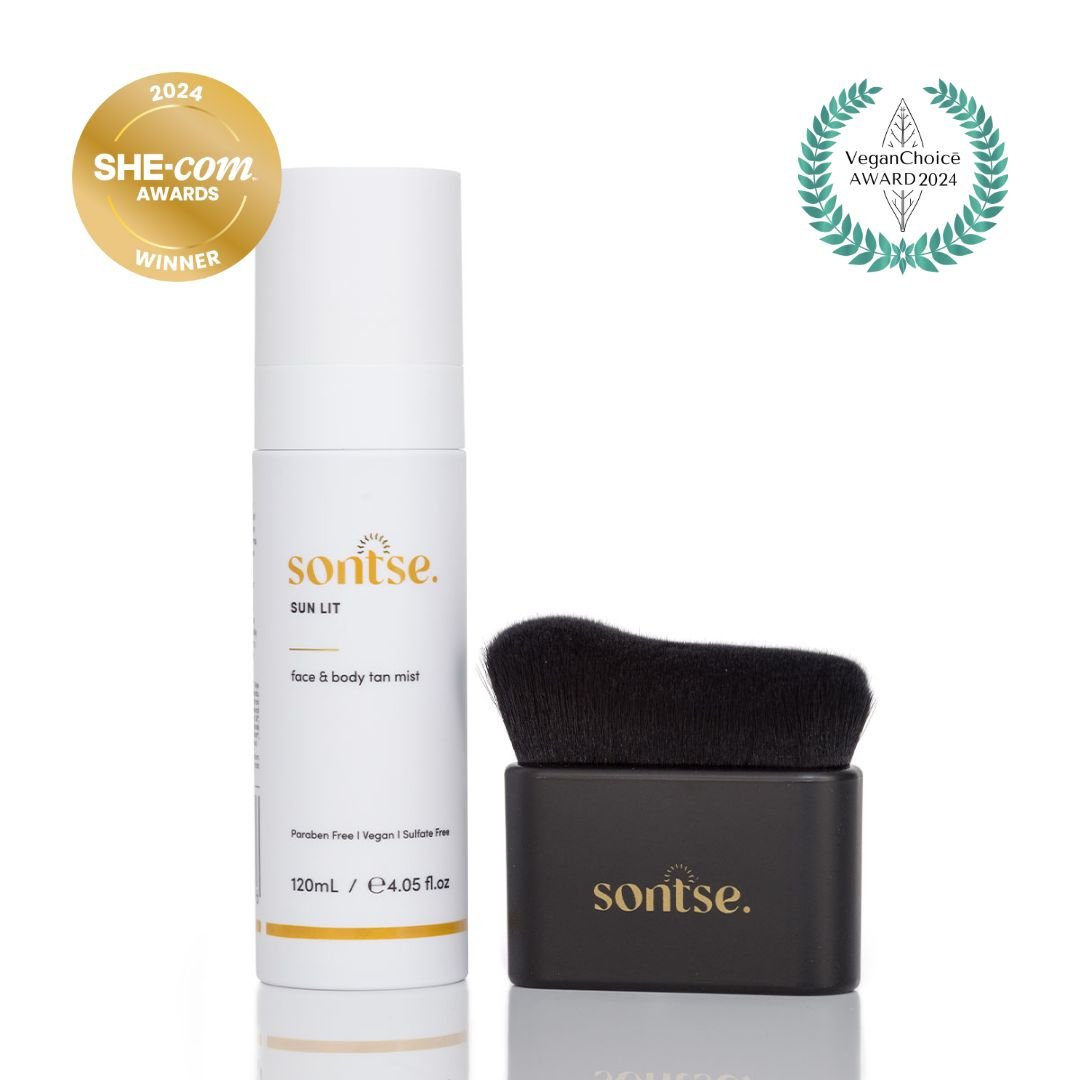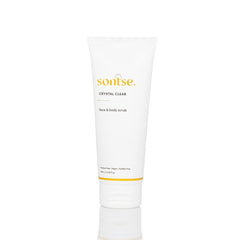Trying to practice safe sun exposure but concerned you’re not getting enough vitamin D?
At Sontse. we are all about shining a light on sun safety, and empowering girls, women, and mummas with the scientific facts when it comes to protecting their skin for true, radiant wellness. If you’ve been conflicted with trying to be sun-safe but feeling concerned that you’re putting your vitamin D levels at risk, here’s a quick and simple-to-read guide on how much sun you really need for a vitamin D fix.
“Talking to people about sun safety every day, I’ve noticed Vitamin D is a common objection to sun safe behaviour. It’s important to look out for the illusory truth effect, which is where you hear something repeated and begin to view it as trustworthy, regardless of the source. What we know to be true is that UV radiation is carcinogenic, that we have high levels of skin cancer in Australia, and that we need Vitamin D for strong bones.”
- Hannah English, Beauty Scientist
Before we get carried away… What is vitamin D?
Vitamin D is a hormone that is synthesised in your body when the cholesterol in your skin is exposed to ultraviolet B (UVB) in sunlight. It is also a form of vitamin readily available in some foods, which means there are a few ways you can get this health-promoting vitamin into your life.
When it comes to the nitty-gritty, there are two main forms of vitamin D that are important for human health: vitamin D2 (ergocalciferol) and vitamin D3 (cholecalciferol). Vitamin D2 is found in some plant-based foods and is also found in fortified foods. Vitamin D3 is the form made by the body when the skin is exposed to sunlight and is also found in animal-based foods such as fatty fish, eggs, and fortified dairy products.
“Both forms are then activated in the liver and kidneys.”
- Hannah English, Beauty Scientist
Why is vitamin D so important? Tell me all the benefits of vitamin D for skin, please!
It seems to be the buzzword in health and wellness circles. So is it just hype? Or is it essential… what does vitamin D do?
According to Better Health, ‘Vitamin D is a hormone that controls calcium levels in the blood. It is needed for strong bones, muscles and overall health.’
In the National Institutes Of Health (2022) it is also suggested that vitamin D plays other important roles in the body, including reducing inflammation, assisting cell growth, improving immune function, and supporting calcium and glucose metabolism.
But the goodness doesn’t stop there, the benefits of vitamin D for skin health are just as impressive.
In an article by the NCBI, the study showed that vitamin D is essential in the formation of the skin barrier, as well as helping to provide antimicrobial effects that kill off invasive organisms, which in turn helps skin wound healing. In some instances, conditions like psoriasis, atopical dermatitis, vitiligo, hair loss and more are improved when adequate levels of vitamin D are present. (Mostafa & Hegazy, 2015)
So is it just a craze? Or is vitamin D a pretty important building block in the body? We think the evidence speaks for itself, but how much vitamin D do you really need?
“There’s a therapeutic window for Vitamin D, like any vitamin. Too little and you’re deficient, too much and you experience unwanted side effects. Lucky for us, our bodies are pretty good at knowing what they need to maintain homeostasis.” - Hannah English, Beauty Scientist
What is the recommended vitamin D normal range? Aka vitamin D levels Australia
If you’re wondering if your vitamin D is in normal range, the average recommended vitamin D levels in Australia for an adult is above ≥50 nmol/L toward the end of winter and anywhere from 60-70 nmol/L during the summer months. (Healthy Bones Australia, 2023)
Of course, the daily requirement of vitamin D will vary according to age. So now comes the important part… how much sun exposure is necessary for reaching your vitamin D needs?
How much sun exposure for vitamin D is really that necessary?
Getting vitamin D from the sun is essential, but not in the quantities that we may think. This is why it’s important to look into how much sun exposure for vitamin D is actually necessary for optimum health.
According to Melanoma Institute Australia (2022), ‘In Australia, incidental sun exposure, particularly in the summer months, is thought to be enough to support adequate vitamin D synthesis.’
The Cancer Council goes on to confirm this, suggesting that in Australia, ‘For most people, adequate vitamin D levels are reached through regular incidental exposure to the sun. When the UV Index is 3 or above (such as during summer), most people maintain adequate vitamin D levels just by spending a few minutes outdoors on most days of the week.’
This does vary according to the season, though. According to The Cancer Council, in the later autumn and winter months in the southern areas of Australia, when the UV Index is below 3, spending time outside midday with some skin uncovered can help raise your vitamin D levels.
Overall, it is not advised to practice sun exposure for the purposes of reaching adequate Vitamin D levels, which can be achieved through proper supplementation. (Melanoma Institute Australia, 2022).
Does sunblock stop Vitamin D absorption? Can you get vitamin D through sunscreen?
So how do we get vitamin D from the sun safely? And can you still get vitamin D while wearing sunscreen?
It’s said that just a few minutes outside, midday, most days with your skin uncovered will be enough to safely boost your vitamin D levels. This means, you can get away with a few minutes of sunscreen-free skin exposure daily, and in fact, it may be beneficial. However, as a general rule, whenever the UV Index is 3 or above, it is important to wear sunscreen. (The Cancer Council, n.d.).
“It’s also important to utilise other sun safety practices, like wearing a hat and covering up with clothing, wearing sunglasses and seeking shade.”
- Hannah English, Beauty Scientist
If you’re asking tough questions like ‘Does sunblock stop vitamin D absorption’ and ‘Can you get vitamin D through sunscreen?’. Oh, how we love you. You are totally our kinda people because you clearly care about what’s best for your body long-term… which is a strong value we hold dearly at Sontse.
As the more skin-conscious brand when it comes to sunless tanning products, our range is developed with sun-safety top of mind. Understanding that getting that bronze summer glow just isn’t achievable in the three minutes of daily sun exposure, we’re advised, our range is curated to give you a tan sans the sun damage. Plus, it’s sunscreen friendly! This means you can apply that sunscreen daily without it messing up your tan.
“Short version: because sunscreen will never block out 100% of UV radiation, we know that your body will create Vitamin D regardless. Slip, slop, slap!”
- Hannah English, Beauty Scientist
What are other natural sources of vitamin D?
The following is a quick rundown on how to get vitamin D through vitamin D-rich foods, vitamin D supplements and some of the best sources of vitamin D.
So what foods are high in vitamin D, and how can we get vitamin D naturally from our food?
According to Better Health (2007), you can get around 5-10% of your daily requirements from foods like:
-
fatty fish (such as salmon)
-
eggs
-
margarine and some milk
-
some cereals
These are great vitamin D food sources that can give you a daily boost.
You can also supplement vitamin D in pill, powder or liquid form. Blackmores is a reputable brand in Australia that can be bought in most supermarkets.
But can you have too much vitamin D?
Can you have too much vitamin D? It is nearly impossible to get too much vitamin D from diet and sun exposure alone. Nonetheless, extended periods of time in the sun (especially unprotected) can increase the chance of skin cancer. (Better Health, 2007)
This is where vitamin D supplementation with a tablet, powder or liquid supplement can be helpful. Please be aware, though, it’s important to remember that too much of a good thing can have negative effects.
If using a high-dose supplement or overdosing past the recommended amounts, you can be at risk of vitamin D toxicity. Always be sure to speak with your doctor about the recommended dose for your lifestyle.
Are there any vitamin D side effects? Can you overdo it?
Fallen in love with the benefits of vitamin D and tempted to go hard or go home? Please don’t. It’s important to be aware of the negative effects of too much vitamin D. According to the National Institutes of Health (2022), some vitamin D side effects that may pop up if you’re popping those pills a little too hard include:
-
nausea
-
vomiting
-
muscle weakness
-
confusion
-
loss of appetite
-
dehydration
-
excessive urination and thirst
Always consult your doctor should you notice these symptoms arise after frequent use of vitamin D.
So now that we’ve discussed everything regarding too much vitamin D, how do you know if your body has a lack of vitamin D?
How do you know if you are vitamin D deficient?
Some tell-tale signs that you may be experiencing a vitamin D deficiency include but are not limited to:
-
Fatigue, lethargy or weakness
-
More frequent infections or lower immunity
-
Mood disorders or depression
-
Slower wound healing
-
Hair loss and thinning of the hair
And in severe cases, cancer, osteoporosis, rickets in children and osteomalacia in adults. However, a lot of these symptoms of vitamin D deficiency can also have other causes, so be sure to get your vitamin D levels tested with a registered GP.
How do you test your vitamin D levels?
Asking all your besties if they know how to test your vitamin D levels? It’s so simple, girlies. Just pop to your local GP and ask for your routine bloodwork with vitamin D included. You should get a slip to go to Pathology and get your bloods drawn.
When the results are in, spend some time with your doctor and ask them to explain how your vitamin D levels look, whether supplementation is required and if so, which form of supplementation will be appropriate for you.
So there you have it, everything you need to know about vitamin D. If you’re realising that you’ve been overexposing your skin to the sun but still want that post-holiday glow, here are a few tips on how to tan quickly and safely… with zero time in the sun!
Written By Liana Pantalone – Beauty & Skincare Copywriter at Climbing Vine Co.
References
Better Health. (2007, June 06). Vitamin D. Better Health Channel. Retrieved May 10, 2023, from https://www.betterhealth.vic.gov.au/health/healthyliving/vitamin-d
The Cancer Council. (n.d.). Vitamin D. Cancer Council. Retrieved May 10, 2023, from https://www.cancer.org.au/cancer-information/causes-and-prevention/sun-safety/vitamin-d
Health Direct. (n.d.). Vitamin D and your health. Healthdirect. Retrieved May 10, 2023, from https://www.healthdirect.gov.au/vitamin-d-and-your-health
Healthy Bones Australia. (2023, May 02). Vitamin D & Bone Health | Sunshine and Vitamin D. Healthy Bones Australia. Retrieved May 10, 2023, from https://healthybonesaustralia.org.au/your-bone-health/vitamin-d-bone-health/
Melanoma Institute Australia. (2022, March 1). Sunscreen FAQs. Melanoma Institute Australia. Retrieved May 10, 2023, from https://melanoma.org.au/about-melanoma/how-to-prevent-melanoma/sunscreen-faqs/
Mostafa, W. Z., & Hegazy, A. (2015, November). Vitamin D and the skin: Focus on a complex relationship: A review. NCBI. Retrieved May 10, 2023, from https://www.ncbi.nlm.nih.gov/pmc/articles/PMC4642156/
National Institutes Of Health. (2022, November 8). Vitamin D - Consumer. NIH Office of Dietary Supplements. Retrieved May 10, 2023, from https://ods.od.nih.gov/factsheets/VitaminD-Consumer/
Norval M, Wulf HC (October 2009). "Does chronic sunscreen use reduce vitamin D production to insufficient levels?". The British Journal of Dermatology. 161 (4): 732–6. doi:10.1111/j.1365-2133.2009.09332.x. PMID 19663879. S2CID 12276606.





















